I am counting again. It comes up now and then like a nervous tick. I notice it most when I am outside walking and preoccupied with some interior thought. Suddenly I hear the sound of my counting; how many steps to my front door, how many trees line the street or how many rows of grass to mow in a section of lawn. It’s embarrassing; an obsession that keeps me from experiencing what’s around me. I sternly forbid any more counting, abstaining like an alcoholic. Soon, however, I forget to be wary and I slip back into it again, this preoccupation with the count, the soul of music.
I have long been fascinated with rhythm in my music – how to shape the energy of a piece, like a band of shimmering movement. My interest is in how it transforms, moves from one state to another, interrupts itself, then doubles back. Sometimes it is a stream of water bouncing down a curling bed, glancing off rocks and edges. Other times is it a hot liquid metal, slithering, pulsating, spurting, angry, and insistent. Whether whimsical or full of power, it is the rhythms that often take a listener to a breaking point.
But I am getting ahead of myself. First, a bit of back ground on how I understand and relate to rhythm.
Music, for me, in its crudest form is three things: organized sound, duration and silence. Sound is the pitch (high and low). Duration has to do with time, both as the invisible net in which sound floats (how long the piece is), and the length of each individual sound, or rhythm. Silence is the great back drop and rarely intrusive. It acts as a foil to contents of music, bringing it into relief.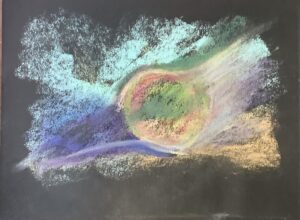
Rhythm is organized around a pulse, a steady continuous beat that hides in the background. The pulse can be fast or slow becoming the tempo or the speed of the music, but its primary role is to be the skeleton-form on which rhythm rests. For convenience, these pulses are corralled in countable units or measures, commonly 3, 4, 6 or 12. These keep the performers from flying out of place and loosing themselves completely.
The downbeat, for me, is the star of the measure. Its genesis, most likely, comes from walking. Stepping out to walk four steps, the dominate leg (usually the right leg) takes the lead, making a slightly firmer emphasis on the first step, and again on the third step. The first of these is the down beat, a natural emphasis of the measure.
Walking in groups of three is slightly different. The first group starts on the dominate leg (RLR), but the second grouping uses the nondominant leg (LRL). I almost stumble as I walk the pattern on my studio rug; the slight-off-centeredness catches my imagination.
I play with the magical insistence of downbeats. I am forever adjusting groupings of continuously running fast notes – like the sound of steady rain – not mathematically or intellectually, but in a playful, natural kind of movement.
This is where I begin. I am counting in a steady fast pace, let’s say 123 123 over and over. The first in the series is the downbeat that I feel as a little pulse. Then, wanting a change, I add them together, 123456 123456. Now the distance between downbeats is longer. Feeling a bit sassy, I put these groups together, 123 123 123456. Counting steadily, snapping my finger on each 1, I feel a lift in the last grouping, as if the 456 can’t keep their feet on the ground and are curling upwards.
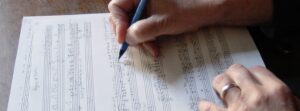 There, right there is the magic – that lift, as if you were about to fly. The upward motion pulls at gravity. I am a kayak, rushing downstream only to hit a rock. As I fly in the air, the suspension seems longer than possible; my heart stops beating for a endlessly long moment – time is distorted.
There, right there is the magic – that lift, as if you were about to fly. The upward motion pulls at gravity. I am a kayak, rushing downstream only to hit a rock. As I fly in the air, the suspension seems longer than possible; my heart stops beating for a endlessly long moment – time is distorted.
In truth, this is the way I feel my own energy. Restless and seeking, I move from one slight change to another, but always in a context that makes sense, and has an inner logic or glue. As the pressure heightens, I burst out into a calm, an arching melody of understanding perhaps. There is an interplay between the instruments, before I collect my wits about me, and dash on, back into the pulse of life.
This leads me to another question, what happens when my rhythms run out of energy? I imagine a marathon race where I am running and running. I am becoming more and more physically tired, although my pace has not changed. The moment when all my physical energy is depleted, I am unable to stand and fall towards the ground. In that vulnerable moment, I transform, and go upwards.
Isn’t it so in life? Significant change often happens when I stumble, or am so exhausted I can no longer resist. And then, the rhythm moves me upwards to what ever name I call it at the moment – God, higher power, the cosmos. I escape gravity.
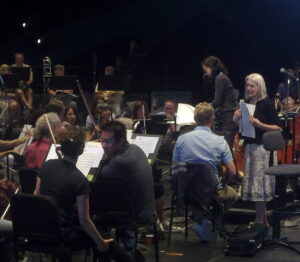 In the music world, a new piece is premiered after working with the performers in rehearsals. We confer about tempos, do a last bit of editing, talk about the musical heart of the piece and how to express it. At the performance, I introduce the work to the audience, or do a pre-concert presentation. But mostly, I am in the audience, listening. I stand for the applause, usually from my seat, or bound up to the stage for a quick bow. During the intermission and after the concert, a few audience members warmly clasp my hands. But most of them dodge around me. Did they not like my work? Or is it too vulnerable to express an opinion face to face?
In the music world, a new piece is premiered after working with the performers in rehearsals. We confer about tempos, do a last bit of editing, talk about the musical heart of the piece and how to express it. At the performance, I introduce the work to the audience, or do a pre-concert presentation. But mostly, I am in the audience, listening. I stand for the applause, usually from my seat, or bound up to the stage for a quick bow. During the intermission and after the concert, a few audience members warmly clasp my hands. But most of them dodge around me. Did they not like my work? Or is it too vulnerable to express an opinion face to face?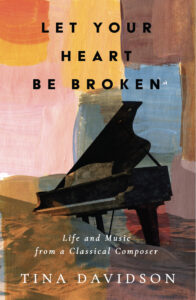 podcasts, interviews, and book tours. I get emails, messages or posts from readers, sometimes several over a week, letting me know they are halfway through, almost done, they couldn’t put it down until 4 AM. It reads like a thriller, has a musical lilt, they resonated with my words. I have introduced them to contemporary music, articulated something about composing andmy deep relationship to sound – I have put words to an art form that is generally wordless. They feel let in.
podcasts, interviews, and book tours. I get emails, messages or posts from readers, sometimes several over a week, letting me know they are halfway through, almost done, they couldn’t put it down until 4 AM. It reads like a thriller, has a musical lilt, they resonated with my words. I have introduced them to contemporary music, articulated something about composing andmy deep relationship to sound – I have put words to an art form that is generally wordless. They feel let in.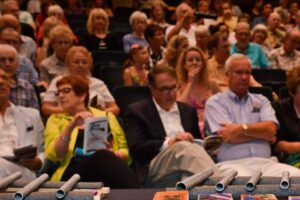 performing abilities. The works they perform are primarily historical, often hundreds years old, and referred to as masterpieces. Contemporary music – our living culture – is not performed with any regularity.
performing abilities. The works they perform are primarily historical, often hundreds years old, and referred to as masterpieces. Contemporary music – our living culture – is not performed with any regularity.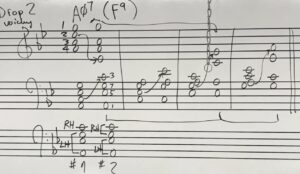 performance, harmony, counterpoint, set-theory, analysis and orchestration before pencil hits the paper. The canon maintains that understanding music history is an essential, and without it the artist gropes in the dark in a vain attempt to reinvent the wheel. The canon implies an order – one must do A before B. It reinforces that personal creativity is not trustworthy unless it is in an old container: it is not credible without context. In other words, one must be coupled to the past to make authentic, groundbreaking art.
performance, harmony, counterpoint, set-theory, analysis and orchestration before pencil hits the paper. The canon maintains that understanding music history is an essential, and without it the artist gropes in the dark in a vain attempt to reinvent the wheel. The canon implies an order – one must do A before B. It reinforces that personal creativity is not trustworthy unless it is in an old container: it is not credible without context. In other words, one must be coupled to the past to make authentic, groundbreaking art. a personal ownership that grows out of doing. I support experiencing writing music before too much comparison. In the initial stage, I want everyone to compose the way they painted in kindergarten. Hardly knowing how to hold a paint brush, they work with abandon and in full confidence of their creative abilities.
a personal ownership that grows out of doing. I support experiencing writing music before too much comparison. In the initial stage, I want everyone to compose the way they painted in kindergarten. Hardly knowing how to hold a paint brush, they work with abandon and in full confidence of their creative abilities.